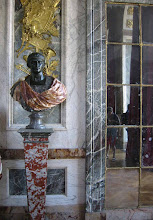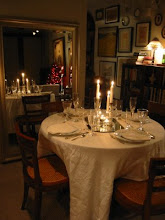As many of you know, blogger Heather Clawson has released a book entitled Habitually Chic, Creativity at Work. The book chronicles the work spaces of many creative designers and is thoroughly inspiring.
I've been planning my own blogging work space in my new apartment and the book has provided me with a lot of ideas. I took it to bed one night and stayed up way too late reading all of the interviews and exploring the detail shots. Most amazing is that Heather took all of the photos herself!
Heather is a dear friend of mine but despite that I am truly so in love with this book, relationships aside (and I'm honored to even be included in the acknowledgements)!
After reading the book and my trip to Market I wondered just how one could create their own Habitually Chic workspace? The Highpoint showrooms provide a lot of inspiration on their own. The Alice Desk by Alexa Hampton for Hickory Chair is great for a small space so you can hide the mess away!
Also at Hickory Chair was a workspace set up utilizing a dining table and chairs. I may be using my dining room as an office in my own apartment so this was great to see in place.
The Jasper Writing Desk by Mariette Himes Gomez for Hickory Chair is a beautiful piece of furniture and I especially appreciate the drawer locks and metal feet!
Jeffrey Alan Marks designed this stunning Middlefork center table for his new collection for Palecek which I think would make a great workspace.
The most beautiful collection I've seen in years and everyone was talking about at Market was by Thomas Pheasant for Baker.
I snapped these photos at the product launch party in the Baker Georgetown store. The details on the desk are beautiful: the greek key, the square brass pulls, and that metal stretcher detail.
And what is the perfect workspace without lighting? I loved the Bacco floorlamp from Julian Chichester which frees up workspace. For a larger desk where space isn't at a premium this capitol lamp from Regina Andrew fits the bill. Now go get inspired by checking out Heather's book!
First three images from Habitually Chic: Creativity At Work by Heather Clawson, published by powerHouse Books. Other snapshots are my own.
Thursday, November 1, 2012
Wednesday, October 31, 2012
The Houses of James Means
Last weekend I attended the estate sale of a retired British antiques dealer here in DC and one of the treasures I picked up was a book on the Houses of James Means. I've been attending a lot of these local estate sales recently to feather my new nest.
The majority of Means's work is in the Atlanta, Georgia area and his name is still a catch phrase with many realtors in that region. A steadfast classicist in an age of modernity, his work heavily influenced Atlanta's residential architecture and many developers still working in the city. See a contemporary photo of the above house at Things that Inspire blog HERE.
What I find most surprising is that Means incorporated a lot of reclaimed materials to lend patina to his classical designs. Bricks from torn down churches, wood beams from barns, etc. This sounds very avant garde to many of us but Means was doing this as early as the 1950s! While rooms had been imported from Europe for generations before, actual building materials was a bit unusual.
His work was heavily split between beautiful Colonial and Georgian houses, and French Provincial. I love his lean interpretation of these French styles, many based on actual chateau.
The Haverty Residence in Atlanta was inspired by the James River houses in Virginia. No planting beds were created against the house in European fashion. The cobblestone parking court was saved from Atlanta cobblestone streets which were being torn out.
The brick on the front facade was reclaimed from the Federal Reserve in downtown Atlanta, the columns on the rear porch were rescued from another building downtown, the balusters in the terrace wall above were from a Charleston, South Carolina house and the heart pine floors throughout were rescued from a house in Athen's Georgia.
The paneling in the interior was also built of reclaimed heart pine which took a year to collect.
The Hedges Residence was based on the Chateau Chantecaille in Touraine and sits on the crest of Lookout Mountain in Tennessee.
The brick, cobblestones, interior woodwork, doors and hardware here too were all salvaged from demolition sites. One problem during construction was to instruct the workmen to not make all of the salvaged materials too perfect and to keep some age on them!
The Moore residence in Atlanta was inspired by the houses of Charleston with a piano nobile above a full basement with double stairs to the main level.
The materials in this project were not reclaimed but were all hand-made or honed.
Each room features a custom designed surround and mantel with raised paneling and over-mantels.
A Palladian window at the staircase floods the front hall with light. You never know what you'll find at an estate sale!
The majority of Means's work is in the Atlanta, Georgia area and his name is still a catch phrase with many realtors in that region. A steadfast classicist in an age of modernity, his work heavily influenced Atlanta's residential architecture and many developers still working in the city. See a contemporary photo of the above house at Things that Inspire blog HERE.
What I find most surprising is that Means incorporated a lot of reclaimed materials to lend patina to his classical designs. Bricks from torn down churches, wood beams from barns, etc. This sounds very avant garde to many of us but Means was doing this as early as the 1950s! While rooms had been imported from Europe for generations before, actual building materials was a bit unusual.
His work was heavily split between beautiful Colonial and Georgian houses, and French Provincial. I love his lean interpretation of these French styles, many based on actual chateau.
The Haverty Residence in Atlanta was inspired by the James River houses in Virginia. No planting beds were created against the house in European fashion. The cobblestone parking court was saved from Atlanta cobblestone streets which were being torn out.
The brick on the front facade was reclaimed from the Federal Reserve in downtown Atlanta, the columns on the rear porch were rescued from another building downtown, the balusters in the terrace wall above were from a Charleston, South Carolina house and the heart pine floors throughout were rescued from a house in Athen's Georgia.
The paneling in the interior was also built of reclaimed heart pine which took a year to collect.
The Hedges Residence was based on the Chateau Chantecaille in Touraine and sits on the crest of Lookout Mountain in Tennessee.
The brick, cobblestones, interior woodwork, doors and hardware here too were all salvaged from demolition sites. One problem during construction was to instruct the workmen to not make all of the salvaged materials too perfect and to keep some age on them!
The Moore residence in Atlanta was inspired by the houses of Charleston with a piano nobile above a full basement with double stairs to the main level.
The materials in this project were not reclaimed but were all hand-made or honed.
Each room features a custom designed surround and mantel with raised paneling and over-mantels.
A Palladian window at the staircase floods the front hall with light. You never know what you'll find at an estate sale!
Subscribe to:
Comments (Atom)


































































.JPG)







































































